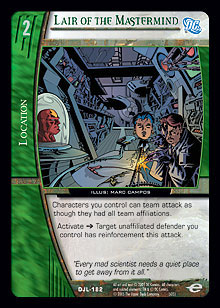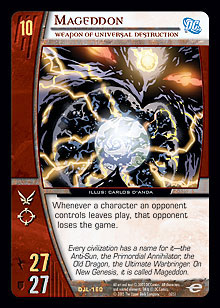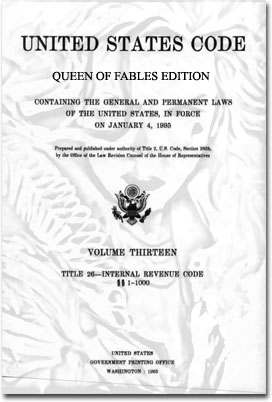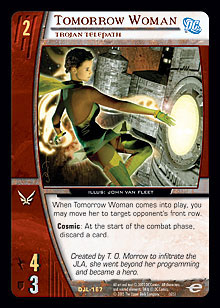
(Editor’s note: This is the first in a weekly series of articles by the Justice League of America set’s lead designer, Matt Hyra. He will be writing about the teams, the characters, and various aspects of the process of creating a new set.)
You’ve just returned from a JLA Sneak Peek tournament, surprised to see a fifth team in the set that we didn’t preview. Okay . . . maybe calling them a team is unfair, as none of the thirteen characters actually have a team affiliation.
Every playgroup has one guy who’s working on “the Ultimate Unaffiliated deck.” It started way back with Mojo, the first unaffiliated character around which a deck could really be built. The problem was that there were only generic support cards to help the deck. Well, with thirteen new unaffiliated characters in the set (tied for the most with DC Origins) and some new support cards, unaffiliated deckbuilders should be very happy.
 But almost more important than the slew of new unaffiliated characters are the support cards. Lair of the Mastermind is a must-have for an unaffiliated deck or any deck that uses a few unaffiliated guys. It does almost the same thing as Green Lantern’s Mosaic World, but the difference is worth noting. The Lair is better for on-curve strategies because it’s likely that your characters are at least as big, if not bigger, than your opponent’s characters. Unaffiliated guys often get a slight stat boost for all the suffering they endure without a team to back them up. If you don’t have to exhaust to reinforce, it increases the odds of making an off-initiative attack. If you’re playing an off-curve Mojo-style deck, you’ll probably do better with Mosaic World, as it gives you a chance to reinforce several characters.
But almost more important than the slew of new unaffiliated characters are the support cards. Lair of the Mastermind is a must-have for an unaffiliated deck or any deck that uses a few unaffiliated guys. It does almost the same thing as Green Lantern’s Mosaic World, but the difference is worth noting. The Lair is better for on-curve strategies because it’s likely that your characters are at least as big, if not bigger, than your opponent’s characters. Unaffiliated guys often get a slight stat boost for all the suffering they endure without a team to back them up. If you don’t have to exhaust to reinforce, it increases the odds of making an off-initiative attack. If you’re playing an off-curve Mojo-style deck, you’ll probably do better with Mosaic World, as it gives you a chance to reinforce several characters.
That being said, the best thing about these two locations is the text that they share word-for-word: “Characters you control can team attack as though they had all team affiliations.” Suffering a bit of breakthrough isn’t the end of the world. What is the end of the world is when it’s your initiative and you can’t get through your opponent’s biggest character. The ability to team attack is the real benefit of these locations.
Two plot twists in the set give a “cookie” to the unaffiliated: Resistance is Useless and Wheel of Misfortune. The Wheel is more of a Sealed Pack card, as there are plenty of ally characters and alternate ways to power-up characters in JLA Sealed. Since the Wheel is so situational, it isn’t likely to be seen in Constructed decks. Resistance is Useless, though, is not useless at all in Sealed or Constructed. The ability to attack a character of the same cost without becoming stunned is always good, and this card gives unaffiliated characters a very good shot at doing that.
So, who are these new unaffiliated characters? Since several of them are rare, you might not have seen them all this weekend, so I’ll go over the list and give you some history. And history is truly where these characters come from. Most of them made their first appearance battling the JLA in its inaugural year (1960–61). The fact that they’re still cool and relevant today is a testament to the vision of the early writers and our loyalty as fans, which grants the ability to turn the cheesy into the nostalgic.
Amazo, Ivo’s Android comes first alphabetically, and what a way to start! As his version indicates, he is an android created by Professor Ivo, who we will meet soon. Amazo has the ability to absorb the powers of anyone with whom he comes into contact. Early designs of the character card had him doing just that. However, when he received three to six abilities, it became quite complicated. So, instead of gaining abilities, we changed him to convert all those cool abilities into big stats. The more opponents he comes into contact with, the stronger he gets. Amazo often takes on the entire JLA and does quite well. If you’re looking for the perfect 8-drop to smash completely through an off-curve deck, this is your guy.
 Despero, Master of the Third Eye is also a long-time JLA foe. His hypnotic power always serves him well against one foe, but against a team like the JLA, he falls short. After being imprisoned by the JLA, he escaped to his home world, where he transformed into a hulking red beast. His boost power represents that. He’s more of a Sealed Pack card than a Constructed one, as his ability can provide your team with some mid-game stability and board position.
Despero, Master of the Third Eye is also a long-time JLA foe. His hypnotic power always serves him well against one foe, but against a team like the JLA, he falls short. After being imprisoned by the JLA, he escaped to his home world, where he transformed into a hulking red beast. His boost power represents that. He’s more of a Sealed Pack card than a Constructed one, as his ability can provide your team with some mid-game stability and board position.
Dr. Destiny, John Dee lives in the dream world, where he turns his victims’ nightmares into reality with his “Materioptikon.” This device is powered by a ruby talisman that belongs to Morpheus, Lord of Dreams. In the design stage, I wanted him to be able to cause a lot of harm to a team that had too much on its mind. And by that, I meant “too many cards in hand.”
The Injustice Gang will call upon the bad Doctor a lot in Sealed play and fairly often in Constructed, as the Gang can fill an opponent’s hand quickly and then put him or her away with a bad dream. The fact that John Dee has concealed gives him a low risk of falling victim to breakthrough. Direct endurance loss is nice, but having a look at your opponent’s hand will often cause the real nightmare.
Felix Faust, Infernal Dealmaker is a classic wizard whose specialty is summoning demonic entities. In this set, we call them Infernal Minions. The three little devils pictured on the card are Abnegazar, Rath, and Ghast, otherwise known as the Demons Three. Felix Faust is probably responsible for summoning them, so the combo between him and them is pretty good. In the early turns of the game, the Minions come out and KO themselves to give their masters some +1 ATK / +1 DEF counters. Probably around turn 5, Felix can summon up to three of the little buggers from your KO’d pile and into play. In Sealed Pack, Felix will see play mainly in the Injustice Gang Army summoning decks, but he also will be found occasionally in Secret Society decks, as the counters that the Minions give work so well for that team.
Kanjar Ro, Kylaq Defense Minister is one of the two unaffiliated leaders in the set, and he’s much more forgiving than the other. Like the four previous characters, Kanjar Ro showed up in the JLA’s first year (1960–61). Kanjar’s attempts to gain political and military power through means both fair and foul have been thwarted by the JLA time and time again. But despite the setbacks, he has plans aplenty (like any good commander of men), and he always returns with a newer, more brilliant, and more cunning idea. In Sealed testing, Kanjar often made the cut as a fourth 5-drop, just in case we had the odd initiative and needed a bit of combat help. Kanjar should make the cut in any unaffiliated Constructed combat deck.
 Mageddon, Weapon of Universal Destruction is only the third 10-drop in the game, and like his predecessors, he has a crazy power. His power prevents your opponent from using Jean Grey, Phoenix Force—or maybe I should say it encourages you to put the two characters together in your deck. It also combos nicely with the new Identity Crisis plot twist from the JLA set.
Mageddon, Weapon of Universal Destruction is only the third 10-drop in the game, and like his predecessors, he has a crazy power. His power prevents your opponent from using Jean Grey, Phoenix Force—or maybe I should say it encourages you to put the two characters together in your deck. It also combos nicely with the new Identity Crisis plot twist from the JLA set.
Created before the dawn of the universe, Mageddon broke out of his space-time imprisonment and drifted toward Earth, raising the intensity of the world’s hatred and violence. His approach started World War III, though the angels of Heaven intervened to stop a nuclear holocaust.
Combat among 10-drops has been rare, as players usually find a way to avoid it, but Mageddon wants to see some action and prevents many of the avoidance tricks your opponent may have. At the end of the turn, if Mageddon is still in play (or if you choose to recover him), you just flat-out win the game if your opponent has to KO a stunned character after recovery. However, this win happens after endurance totals are checked, so if your endurance is in the negatives, you’ll lose before you have a chance to win. While not likely to be found in Sealed Pack decks, making a Constructed deck that can get him into play will be a good challenge for creative thinkers.
Neron, Soul Collector is one of the main reasons I came up with an “evil leader” slant to the keyword, which had only been positive in the Avengers set. Neron tempted many Silver Age villains (and a few heroes) into a power boost at the cost of their souls. You’ll find that a few of the characters he “owns” utilize +1 ATK / +1 DEF counters for various effects. Can you resist the temptation?
Granted, a +1 ATK / +1 DEF counter on up to three of your characters doesn’t seem evil at all to me. If you have the initiative on turn 6, attack first with Neron into your opponent’s 6-drop and hope for a mutual stun. Then, his “evil leader” power that KO’s his minions shuts off, but the counters stay put. When you have the odd initiative, chances are that most of your characters will be stunned and lost anyway. Neron just collects the debt without delay, but the counter gives them a chance to survive an attack. Neron will certainly see play in Sealed Pack—if you’re lucky enough to open him.
If you do get an unaffiliated bomb rare in Sealed, you want to make sure that you draw it when you need it. That’s where Professor Ivo, Anthony Ivo comes in. He’s the first card that allows you to search your deck specifically for an unaffiliated character. Debuting in 1960, he’s waited an eternity to show up in a trading card game, and he intends to be around for another eternity—he’s obsessed with gaining immortality. His evasion should make him nearly immortal on the board. He’ll certainly be an instant addition to the Mojo deck and every other unaffiliated deck that is keyed around one character.
 Queen of Fables, Wickedest Witch is a newer villainess who brings the monsters in storybooks to life. Ongoing plot twists are rather akin to stories, so they are there for her to use and abuse. When the Queen clashed with the JLA, she transported them into a fairytale to face the worst enemies their minds could imagine. She was rewarded for her treachery by being captured in the United States Tax Code. No monsters to summon in that book (except for tax loopholes for the super-rich)!
Queen of Fables, Wickedest Witch is a newer villainess who brings the monsters in storybooks to life. Ongoing plot twists are rather akin to stories, so they are there for her to use and abuse. When the Queen clashed with the JLA, she transported them into a fairytale to face the worst enemies their minds could imagine. She was rewarded for her treachery by being captured in the United States Tax Code. No monsters to summon in that book (except for tax loopholes for the super-rich)!
As one of two characters in the set who can dispatch ongoing plot twists, she makes for a good backup 3-drop in Sealed Pack. In Constructed, her power is perhaps too situational, unless you’re willing to stock your resource row with ongoing plot twists for her to munch on.
Rama Khan, Elemental Magician is also a recent foe of the JLA. He broke Wonder Woman’s unbreakable lasso, so he’s got some street cred. While it was tempting to make this guy great at destroying equipment, his power over the land of Jarhanpur is more interesting. Giving all of your locations the ability to power-up your characters is pretty good, and it will help Rama Khan find his way into a cross-team Sealed Pack build of various ally characters from different teams. The League of Assassins and their location-heavy theme might see use for Rama Khan in Constructed.
Starro the Conqueror, Intergalactic Starfish is probably R&D’s favorite version name in the set. Starro starred in the JLA’s very first appearance (in Brave and the Bold #28 in March of 1960). His Starro Probes attach to people’s faces and allow him to control their minds. While his Probes didn’t make the cut in the set (they were too specific to him), he has the power to pop out any 1-drop Army characters you have in hand when he comes into play. Hopefully, you’ll agree that this is a fair compromise, as they can do their own thing or allow Starro to mind control someone . . . even an opposing 8-drop if you’re lucky and/or good. And he can do it before the combat phase (*cough*—Apocalypse—*cough*).
In Sealed, it’s possible to collect several 1-drop Army characters and pretty easy to get them back into your hand with the Royal Egg Matrix. In Constructed, he’s fun to use, but it can be hard to last long enough to play him. To survive until turn 8, I’d recommend recruiting nothing but Illusionary Warriors for the first three turns. From there, I’m sure you can figure out the rest.
T. O. Morrow, Thomas Oscar Morrow’s first appearance was in 1964, not long after Professor Ivo, and they’ve often teamed together since. They created the 2-drop Tomorrow Woman android, which you’ll see shortly. Red Tornado, John Smith, who was probably Morrow’s greatest android creation, is also a 2-drop. Now you know why Morrow’s power lets him pop 2-drops into play so easily.
In Sealed play, it’s a bit difficult to get a hold of enough 2-drops to make him worthwhile, but it can be worth it, especially if you manage to get a Membership Drive or two. In Constructed, you can put a bunch of 2-drops in your deck and go to town. Just make sure you don’t use four of each, or uniqueness concerns will stymie you.
 Last, but certainly not least, is the aforementioned Tomorrow Woman. She has one of my favorite weird abilities in the set. The character has big stats, so giving her away won’t always be the right answer. Sometimes it’ll be worth it to lose a card once or maybe even twice to have a 2-drop in a low 3-drop’s body. However, if you have some defenses or recognize that your opponent is playing a Control deck that won’t steamroll you, give her away. A Control deck will cry hard at losing cards.
Last, but certainly not least, is the aforementioned Tomorrow Woman. She has one of my favorite weird abilities in the set. The character has big stats, so giving her away won’t always be the right answer. Sometimes it’ll be worth it to lose a card once or maybe even twice to have a 2-drop in a low 3-drop’s body. However, if you have some defenses or recognize that your opponent is playing a Control deck that won’t steamroll you, give her away. A Control deck will cry hard at losing cards.
Keep in mind that T. O. Morrow created her to infiltrate the JLA, but she developed her own feelings and personality and became a hero. If she gets stunned, she loses her cosmic counter—a hard enough jarring will knock that evil programming right out of her. If you’re going to go for the discard strategy, try using her master as the conduit. On turn 4, with T. O. Morrow already in play, spend 1 resource point on his ability. Then recruit Tomorrow Woman for 1 and give her to your opponent. Repeat two more times. Because you’re giving her to your opponent, the uniqueness rule does not apply—you don’t control her. At the start of combat, your opponent will have to discard three cards. Ouch! The best part is that Morrow’s stats are 2 ATK / 6 DEF. Even if Tomorrow Woman attacks him, he won’t stun her back, so she’ll keep the cosmic counter to ruin your opponent’s hand next turn as well.
It’s so evil, you’d think I’d planned it that way. For more on the planning that went into the set and the team themes, tune in next week. Send questions or comments to mhyra@metagame.com.